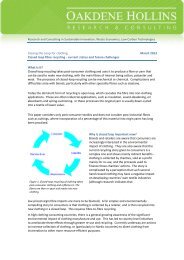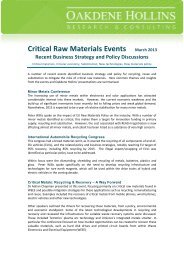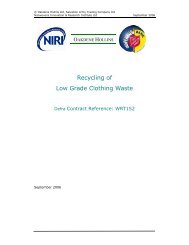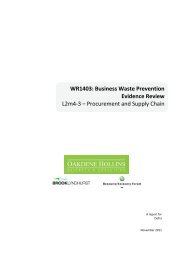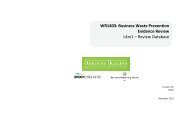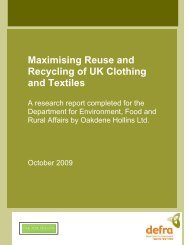Fire Retardant Technologies: safe products with ... - Oakdene Hollins
Fire Retardant Technologies: safe products with ... - Oakdene Hollins
Fire Retardant Technologies: safe products with ... - Oakdene Hollins
- No tags were found...
You also want an ePaper? Increase the reach of your titles
YUMPU automatically turns print PDFs into web optimized ePapers that Google loves.
The FR technology hierarchy assumes in each case that the required product fire retardancyis achieved; in order of priority the hierarchy is:Use of inherently fire retardant materialsDesign of <strong>products</strong>Use of chemical fire retardantsIn turn, the human and environmental impact of chemical fire retardants can also beassessed and minimised by adopting the following hierarchy of assessment, which is linkedto current Ecolabel practice:Use of risk phrasesProhibited and allowable chemical classesExemptions = where no alternative approach will enable fire <strong>safe</strong>ty tobe maintainedWhite List - in which all chemical fire retardants are prohibited <strong>with</strong> theexception of named chemicals that have been incontrovertibly shownto be of very low hazard and enable fire <strong>safe</strong>ty to be maintained.This approach however is in turn constrained by the following factors:Meeting legislative requirementsMaintaining a degree of commercial choiceCost – to the product manufacturer and the consumerIt should be noted that no attempt has been made to include any assessment of life cycleenvironmental performance; however such assessments could form part of a more thoroughevaluation in the future.Are Current EU Ecolabel Criteria Fit For Purpose?To answer this question we have considered the position of each product group in regard tothe current EU Ecolabel criteria and those that might be considered in the future. We havealso addressed some generic issues that affect all ecolabels.Use of Halogenated FRsThere is a drive from some retailers (see Annexe 3) in conjunction <strong>with</strong> environmentalorganisations to replace chlorinated FRs, but concerns are not as great about thesecompounds, as they are for brominated FRs. For example, some of the chlorinatedphosphorus FRs used in foams are not subject to adverse risk phrases.Generally for the non-halogenated FRs there is some uncertainty about their FReffectiveness across different polymer types. In many cases, these compounds can meet therequirements just as the halogenated FRs can, providing acceptable environmentalperformance, although very few have been risk assessed to date. Until this is achieved itwould be perverse to exclude a compound like TCPP by over-restrictive Ecolabel criteriacentred on excluding all halogen containing and additive FRs.Blanket bans by chemical moiety or reaction mechanismP a g e 14 |




